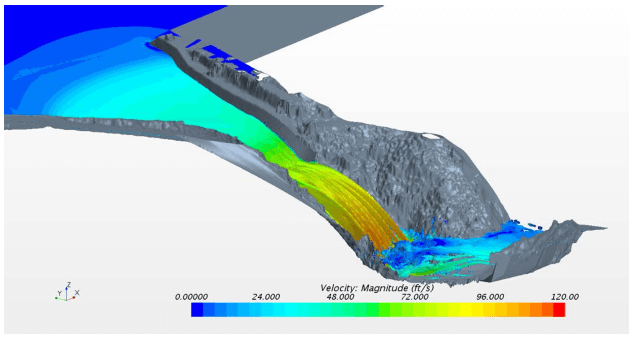Computational Fluid Dynamics (CFD) Services
Primary Flow Signal has partnered with the Utah Water Research Laboratory (UWRL) offering CFD services. UWRL has a depth of expertise in numerical modeling utilizing Computational Fluid Dynamics (CFD). This powerful tool is capable of assisting individuals solve their complicated flow problems and identify performance characteristics. CFD solves the very complex Navier-Stokes equations which describe viscous fluid motion.
Using state-of-the art software (Star CCM+) coupled with cloud or local computing resources, very large problems including reservoirs, associated spillways or complex piping systems can be solved. With the ability to simulate multi-phase fluids, particularly when dealing with the air-water interface of free surface flows, it is possible to visualize flow patterns, identify hydraulic concerns, propose solutions to improve performance and insure that those solutions will perform as expected.
In addition to solving free-surface flows, personnel at the UWRL have solved many closed conduit flow problems including those associated with flow meters, valves, pumps, fire hydrants and problems involving viscous liquids or hydraulic conditions not feasible to simulate in the laboratory environment. Flow visualization, pressure distributions and flow and discharge coefficients are readily obtained using Computation Fluid Dynamics.
Recently, CFD has been used to evaluate flow over several large spillways and outlet works of some significant dams in the United States. In addition, the tool has been used to investigate the impact of adverse piping conditions on flow meter and valve performance as well as pump and intake structure performance.
Some of the benefits of Computational Fluid Dynamics modeling include:
- CFD is a useful predictive tool that can be used to evaluate the performance of flow meters, valves or other devices which measure or control fluid flow.
- CFD has demonstrated and proven performance showing the ability to predict discharge coefficients and flow coefficients to within 0.5% or better.
- CFD can be used to develop rating curves of spillways and other control structures.
- CFD models enable pressures and velocities to be taken at any location in the model and pressure or velocity contour plots can be created on any plane allowing visualization flow patterns or pressures at any location in the model.
- CFD models are also built at full scale removing any scaling effects that can be associated with physical models.
- CFD models are cost effective and can be operational within days and enable rapid generation of results.
- CFD enables the forces on elements developed by flowing fluid to be extracted and resolved.
Some examples follow:
CFD at the UWRL




